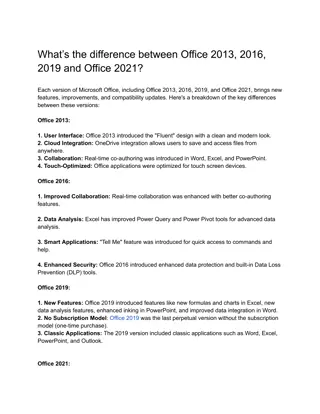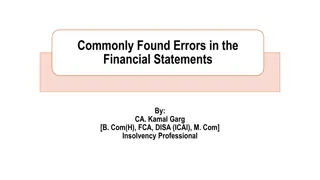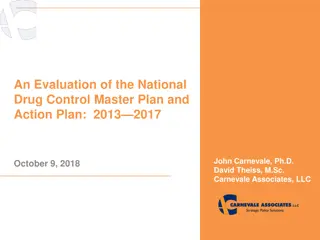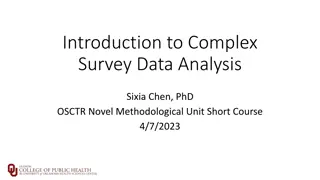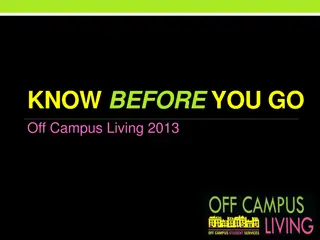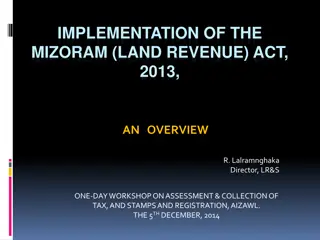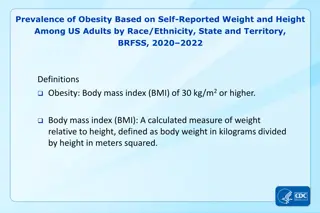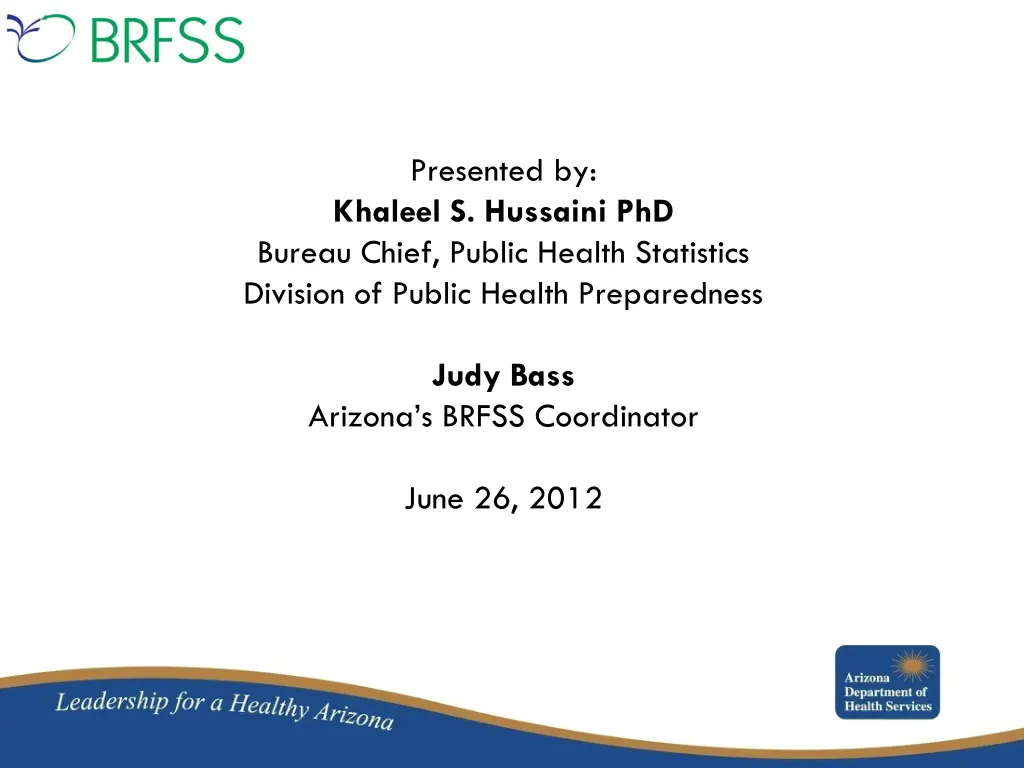
Changes in BRFSS Methods and Population Inferences
"Explore how the Behavioral Risk Factor Surveillance Survey (BRFSS) has adapted to changes in methods, focusing on population inferences through representative sampling. Learn about the importance of the BRFSS weighting process, stratified sampling strategy, and the impact of including cell phone interviewees in data collection."
Download Presentation

Please find below an Image/Link to download the presentation.
The content on the website is provided AS IS for your information and personal use only. It may not be sold, licensed, or shared on other websites without obtaining consent from the author. If you encounter any issues during the download, it is possible that the publisher has removed the file from their server.
You are allowed to download the files provided on this website for personal or commercial use, subject to the condition that they are used lawfully. All files are the property of their respective owners.
The content on the website is provided AS IS for your information and personal use only. It may not be sold, licensed, or shared on other websites without obtaining consent from the author.
E N D
Presentation Transcript
Presented by: Khaleel S. Hussaini PhD Bureau Chief, Public Health Statistics Division of Public Health Preparedness Judy Bass Arizona s BRFSS Coordinator June 26, 2012
What are we covering and what we are not? We are not talking about questions and modules, today but will schedule a separate time and place. We are talking about BRFSS and changes in methods. What are the changes and why? We will not discuss costs. We will not discuss time- lines for the next report. Implications of the changes.
So what are the changes? Any guesses! BRFSS weighting process
The Behavioral Risk Factor Surveillance Survey (BRFSS) was initiated by CDC in1984. It is the largest ongoing telephone survey in the World. Like all surveillance systems BRFSS has adapted to both technical and non-technical changes. Technical terms to remember: POPULATION VS. SAMPLE
...by selecting a representative sample from the population
Disproportionate stratified sample
National Center for Health Statistics Estimates of Cell Phone Only Households in the United States, 2008-2011 Percentage of Households 40 35 30 Percentage of Households 25 20 15 10 5 0 Jan-June '08 July-Dec '08 Jan-June '09 July-Dec '09 Jan-June '10 July-Dec '10 Jan-June '11 Source: Blumberg SJ, Luke JV. Wireless substitution: Early release from the Nation Health Interview Survey, January2008 -June 2011 Available at: http://www.cdc.gov/nchs/data/nhis/earlyrelease /wireless201112.pdf. Accessed June 14, 2012.
According to CDC Cell phone interviewees can now be better represented as the sample is: More likely to be younger; More renters than home owners; More likely to be Hispanic; More likely to be single; There are also differences in attitude and behaviors between cell phone only users and those with landline phones.
WEIGHTING PROCEDURES Why weight?
What is weighting? Sampling weights are needed to correct for imperfections in the sample that might lead to bias. It can include the selection of units with unequal probabilities, non-coverage of the population, and non-response. Data weights take the design weighting and incorporate characteristics of the population and the sample Final Weights (_FINALWT) = Design Weight * some form of data weighting
IN THE PAST. Post-stratification was used as a weighting method. It was based on known demographics of the population. For BRFSS Post-stratification included: Regions within states; Race/ Ethnicity (in detailed categories); Gender ; Age (in 7 categories) Post-stratification forces the sum of the weighted frequencies to equal the population estimates for the region or state by race, age and gender. Post stratification weights are applied to the responses, allowing for estimates of how groups of non-respondents would have answered survey questions.
POST STRATIFICATION VS. RAKING Beginning with the 2011 dataset, raking will succeed post stratification as the sole BRFSS statistical weighting method. Allows for the incorporation of a now crucial variable telephone source (landline or cell phone) into the BRFSS weighting methodology (called _LLCPWT)
WEIGHTING Iterative Proportional Fitting (Raking)
RAKING Rather than adjusting weights to categories, IPF adjusts for each dimension separately in an iterative process. Gender by race/ethnicity Phone source Age by gender Regions within states Age by race/ethnicity The process will continue up to 75 times, or until data converges to Census estimates. Detailed race/ethnicity Renter/owner Martial status Education level
Why Incorporate IPF Now? Computer capacity has increased. Cell phones are becoming larger percentage of the total number of calls. Non-coverage with declining response rates makes weighting more important than ever.
HOW DOES IT IMPACT US? Current Smoking Status (_RFSMOK3) Smoker Non-smoker 100 90 80 84.97 84.09 83.85 81.78 80.28 79.99 70 60 50 40 30 20 20.01 19.72 18.22 16.15 10 15.91 15.03 0 Old weight New weight Old weight New weight Old weight New weight 2008 2009* 2010* *Starting 2009 AZ BRFSS started including cell phones in the samples and hence sampling weights started to include both landline raked weight and cellphone raked weights. Data presented here includes only landline raked weights
HOW DOES IT IMPACT US? Do you currently have a Health Plan? (HLTHPLAN) No Health Plan Health Plan 100 90 86.75 80 85.00 82.17 81.90 79.74 79.00 70 60 50 40 30 20 21.00 20.86 19.10 17.83 10 15.00 13.25 0 Old weight New weight Old weight New weight Old weight New weight 2008 2009* 2010* *Starting 2009 AZ BRFSS started including cell phones in the samples and hence sampling weights started to include both landline raked weight and cellphone raked weights. Data presented here includes only landline raked weights
HOW DOES IT IMPACT US? Flu Shot (_FLUSHOT3/4) Received flushot Did not receive 100 90 80 70 66.29 60 65.16 64.45 63.32 60.98 60.96 50 40 39.04 39.02 36.68 30 35.55 34.84 33.71 20 10 0 Old weight New weight Old weight New weight Old weight New weight 2008 2009* 2010* *Starting 2009 AZ BRFSS started including cell phones in the samples and hence sampling weights started to include both landline raked weight and cellphone raked weights. Data presented here includes only landline raked weights
HOW DOES IT IMPACT US? Body Mass Index (_BMI4CAT) Neither overweight nor obese Overweight Obese 100 90 80 70 60 50 40 39.68 38.73 38.41 38.34 37.51 36.74 30 36.31 35.77 35.69 35.47 35.16 34.18 29.08 20 26.18 26.12 25.89 25.59 25.16 10 0 Old weight New weight Old weight New weight Old weight New weight 2008 2009* 2010* *Starting 2009 AZ BRFSS started including cell phones in the samples and hence sampling weights started to include both landline raked weight and cellphone raked weights. Data presented here includes only landline raked weights
CONCLUSION Raked weights impact differently for different variables. Trend data and comparison cannot be established prior to 2009 due to changes in weighting procedures. In 2008, there was only landline data available and hence raked weights reflected only landline. With introduction of cell phones raking methods incorporated both landline as well as cell phone weights called _LLCPWT. Starting in 2011 CDC will weight data only using raking methods which implies establishing any trends is not feasible.

